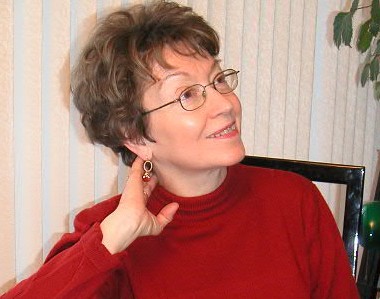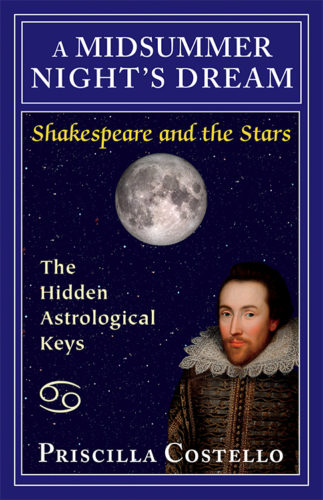TWH — “Lord, what fools these mortals be!” the mischievous sprite Puck says to Oberon the faerie king in Shakespeare’s A Midsummer Night’s Dream.
Shakespeare was no fool when it came to incorporating the magical and astrological worldviews of his time into his immortal works. That’s the premise of the fascinating, exhaustive (but not exhausting) book Shakespeare and the Stars: the Hidden Astrological Keys to Understanding the World’s Greatest Playwright (Ibis Press, 547 p.) by professional astrologer and English literature teacher Priscilla Costello.
Costello weaves not just astrology but extensively-researched aspects of the Elizabethan worldview, Renaissance magic, ancient history, mythology, modern psychology, and more into her examination of Shakespeare’s works. While she discusses the bard’s plays as a whole, Costello delves deep into six specific works, including three of his most “magical” plays: The Tempest (with its story of the exiled nobleman Prospero, who takes up the magical arts and frees the air spirit Ariel), Macbeth (with its “double, double, toil and trouble” witches who prophesy Macbeth’s doom), and A Midsummer Night’s Dream (with its tale of a love quadrangle fostered by a quarrel between Oberon and his faerie queen Titania, and heightened by the errant spell-casting antics of Puck).
For Pagans, Wiccans and Witches who have a term paper coming up for their coven or college freshman literature class, Costello’s six play discussions are being released in handy, 64-page “playbill editions.” A Midsummer Night’s Dream was released last October, and The Tempest and Macbeth are due Apr. 15.

In the introduction of Shakespeare and the Stars, Costello gives her working definition that “astrology consists of the calculation and meaningful interpretation of the positions and motions of the heavenly bodies and their correlation with all aspects of earthly experience.”
That’s followed by a statement that will resonate with the worldview of many Pagans and followers of earth-based religions: “Astrology takes the point of view that we have a relationship with our environment – not just our local environment, or even our global environment, but to the total environment. It is the original holistic philosophy. Put concisely, astrology is the language that connects humanity with both nature and the cosmos.”
That language was especially vibrant in the time of Shakespeare, who lived in Elizabethan England from 1564 to 1616.
“Modern audiences may be surprised at the frequency” of astrological allusions in Shakespeare’s works “since astrology has been marginalized in our day,” Costello writes, “but the audiences of Shakespeare’s time were steeped in its language, partly because the people of his time were more aware of and attuned to the skies than ours.”
An astrological worldview “was so accepted in his time that astrological symbols were used as a kind of shorthand in both philosophical and literary works,” much the way, Costello says, that references to such pop culture fare as Star Wars or The Hobbit function today.
The book’s introduction gives a concise-but-rich overview of Shakespeare the man (history knows precious little about him) and his achievements (Costello quotes revered literary critic Harold Bloom, who said that the bard was the first writer to portray “modern” human beings with all our complex emotions, motivations, and self-aware reflections).
The introduction also details how “astrology permeated Elizabethan culture,” and how Shakespeare naturally tapped into what was a rich vein in his time.
For example, Costello cites the quarreling between Oberon and Titania in A Midsummer Night’s Dream, and how Puck the sprite describes the couple with the line, “but they do square, that all their elves for fear creep into acorn-cups, and hide them there.” Costello then notes that “‘square’ is an astrological term referring to the most conflict-ridden mathematical aspect between two planets or bodies,” and that the bard’s use of that term illuminates the discord between the royal faerie couple.

Priscilla Costello [courtesy].
The section “Decoding Shakespeare” includes such chapters and sub-chapters as “The Elizabethan World Picture: the Framework for Shakespeare’s Plays,” “Climbing the ‘Ladder of Heaven,’” “The Music of the Spheres,” “Mastering the Passions: the Moral Dimension of Shakespeare’s Works,” “The Modern Psychological Perspective on Archetypes,” “Astrology as a Language of Symbols,” and “The Mystery of Artistic Creation and the Genius of Shakespeare – and Did He Create Consciously?”
The chapter on A Midsummer Night’s Dream includes such sub-chapters as “The Moon and the Unconscious” and “The Faeries and the Realm of Faerie.”
Here Costello cites C.S. Lewis’ examinations of ancient literature to reveal that writers from Plato to the Renaissance believed that divine entities existed above the moon while humans populated the earth, but that semi-divine “middle spirits” inhabited the realm between the earth and the moon because no part of creation could be devoid of inhabitants.
A footnote reveals the etymology of the word “faery,” including its first appearance in English in 1450. Another footnote, a page and a half long, traces Shakespeare’s possible inspiration for the ass-headed Bottom back to Greek myth.
A discussion of dreams in Shakespeare — of being “under the sphere of the moon” — references Pythagoras, Jung, kabbalah and that famous passage by the ancient Chinese Taoist sage Zhuang Zhou: “Am I a man dreaming that I am a butterfly, or am I a butterfly dreaming that I am a man?”
The chapter on The Tempest includes such sub-chapters as “Piscean ‘Knowledge’ and the Study of Magic,” “Prospero’s Control of the Four Elements,” and “Is Prospero a White Magician?” Costello examines theories that Shakespeare based Prospero on real-life mathematician and magus John Dee (who, Costello notes, curiously signed some of his letters as “007” centuries before Ian Fleming created James Bond).
Costello also delves into the “magical accoutrements” of a magician, writing that “the ceremonial robe is worn not because it has intrinsic power, but because putting it on, like getting dressed up for the prom, alters your emotional state, helps focus on the ritual to be performed, and prepares your consciousness for an experience that is out of the ordinary.”
In a discussion of the magic circle, she cites Jung, who wrote: “The protective circle, the mandala, is the traditional antidote for chaotic states of mind.”
The Macbeth chapter includes such sub-chapters as “The Key to Macbeth: Mars,” “The Witches’ Persuasive Technique: Equivocation,” and “Scorpio and the Occult.”
Costello notes the many real-life tragedies and associated mayhem that have beset productions of “the Scottish play” ever since its very first performance, in which the boy actor portraying Lady Macbeth took ill and died backstage.
“The atmosphere of evil generated by performances of the play may derive in part from characters in the play deliberately summoning dark forces,” Costello writes. (More detailed and lengthy discussions of the “curse” of Macbeth are available in numerous other sources.)

Elsewhere, a discussion of the importance of the number seven in the Elizabethan worldview references the Sumerian myth of the goddess Inanna, Egyptian pyramid texts and the Christian bible.
Such instances, mind you, are not pedantic “drive-by” references; they are frequently extensive, always enlightening enhancements to the topic at hand.
Costello notes that, despite the plays’ ample evidence of Shakespeare’s knowledge of astrology, the faerie realm, the spirit world, and prophetic dreams, “it is impossible to say definitively what Shakespeare believed . . . because he puts into the mouths of his characters statements that suit their attitudes and personalities. But it is clear that whatever Shakespeare’s personal beliefs, the vast majority of his characters’ statements are overwhelmingly in line with a Renaissance astrological worldview.”
Richard Smoley, a noted writer on worldwide spiritual, mystical and esoteric traditions, employed a broader view in his assessment of Costello’s book: “The truth is now obvious — Shakespeare’s worldview was essentially identical with the occult philosophy of the Renaissance.”
The truth is that “Shakespeare and the Stars” is entertaining and enlightening, and a reminder to modern readers that the roots of astrology and a magical “as above, so below” worldview run deep and wide. The book also reveals another truth: Shakespeare was one mystical, magical dude.
The Wild Hunt is not responsible for links to external content.
To join a conversation on this post:
Visit our The Wild Hunt subreddit! Point your favorite browser to https://www.reddit.com/r/The_Wild_Hunt_News/, then click “JOIN”. Make sure to click the bell, too, to be notified of new articles posted to our subreddit.

Pingback: The Bill / Shakespeare Project presents: This Week in Shakespeare news, for the week ending Monday, March 19th, 2018 | The Shakespeare Standard